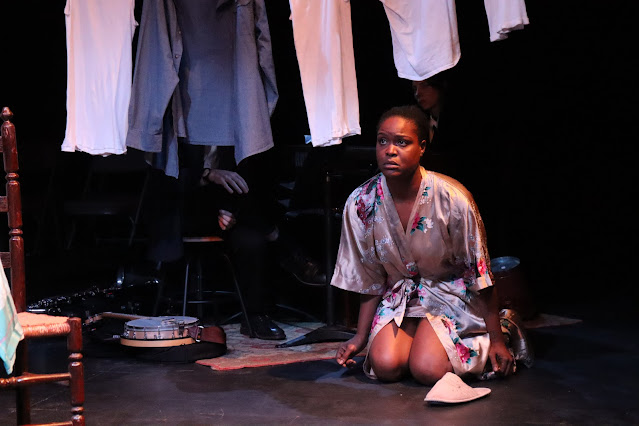It CAN Happen Here!: Hallie Flanagan & the Federal Theatre Project
Written by Melody Brooks, Katrin Hilbe, Tess Howsam, Daniel Jacobs, and Susan Quinn
Directed by Katrin Hilbe
5-25 46th Ave, Queens, NYC
March 6-30, 2025
 |
| It CAN Happen Here!: Hallie Flanagan and the Federal Theatre Project. Photo by Al Foote III. |
Faced with the current, billionaire-led dismantling of the federal government in the United States, it's hard–well, harder–to imagine the level of robust financial support for the theater arts at the national level that is detailed in
It CAN Happen Here!: Hallie Flanagan & the Federal Theatre Project. It's much less difficult to imagine the acts of censorship and accusations of subversion, communism, and race-baiting leveled at theater artists by grandstanding politicians out to destroy that very support. At least in the political landscape of the 1930s, as we learn at one point in this painstakingly researched, inventively staged, and fantastically acted production, a congressman could attract public shame for not knowing who Christopher Marlowe is.
 |
| It CAN Happen Here!: Hallie Flanagan and the Federal Theatre Project. Photo by Al Foote III. |
Shortly after we first meet Hallie Flanagan (Theresa Rose), director of the Federal Theatre Project (FTP), we see her being questioned at a 1938 hearing of the House Un-American Activities Committee (HUAC). The Federal Theatre Project, part of the Works Progress Administration under President Franklin Delano Roosevelt, was created as a way to provide work to theater artists of all kinds during the Great Depression. Despite its large-scale success in providing both relief to the unemployed and the opportunity to experience live theater to Americans nationwide, by time we are introduced to Flanagan, the project's funding was under sustained attack from those in Congress who objected to the socially conscious content of some of the plays that it produced as well as to its commitment to racial integration (all of this should sound dispiritingly familiar). The play then jumps back to the project's 1935 beginnings, and, drawing on Susan Quinn's history of the FTP,
Furious Improvisation, Flanagan's own book, Arena, and transcripts of government hearings, tells the simultaneously inspiring and infuriating story of how Flanagan came to be involved and to grow the project into the all too short-lived success that it became. Twinned with that story is a throughline concerning the strain that Flanagan's work for the good of the masses put on her relationship with Fred (DJ Davis, who contributes some fantastic moments of song), her surviving son from her first marriage.
 |
| It CAN Happen Here!: Hallie Flanagan and the Federal Theatre Project. Photo by Al Foote III. |
An opening anecdote about Flanagan's father introduces the apple as a visual motif in the production symbolizing the imperative to "create the world you need," its red often contrasting with a white papier-mâché aesthetic which evokes the FTP's prioritization of spending its money on hiring people over building elaborate scenery. The aesthetic also connects to the FTP's concept of the "Living Newspaper" play, works based on current events (and thus drawing the ire of some politicians).
It CAN Happen Here! takes an effective dose of inspiration from approaches, keeping its focus on its talented cast and accomplishing a great deal with minimal scenery and props (including some overhead projector shadow puppets and an Eleanor Roosevelt life-size cardboard standee humorously operated by Emma Sarah Davis) and projections of period documents and images. These projections also helpfully identify historical - and a couple of fictional - personages played by the actors, almost all of whom take on a number of roles, including some famous names whose paths intersected with the FTP, such T.S. Eliot, Orson Welles, and, of course, Sinclair Lewis, author of the painfully prescient
It Can't Happen Here. The stage adaptation of Lewis's novel is one of a few works brief portions of which
It CAN Happen Here! smartly integrates into its own unfolding narrative. At the center of this narrative, Rose engrossingly inhabits Flanagan as a woman with vision and a dedication to "real" theater for everyone while affording moving glimpses of the cost of her sacrifice for that vision. The rest of the cast (Nick Radu-Blackburn, Jomack Miranda, Allie Beltran, DJ Davis, Chase Lee, Max Bank, Emma Sarah Davis, Megan Lomax, and Cheyenne Springette) transform themselves into everyone from anonymous reporters to Flanagan's ally Harry Hopkins (Bank) and her congressional nemesis Martin Dies (Radu-Blackburn) with a facility befitting the production's well-judged forward momentum.
 |
| It CAN Happen Here!: Hallie Flanagan and the Federal Theatre Project. Photo by Al Foote III. |
When the FTP's funding was finally eliminated, one of the canceled shows was
Pinocchio, and
It CAN Happen Here! makes poignant use of the character (Beltran) to symbolize the project's demise. At the same time, the list of shows produced by the FTP that scrolls by as the show ends underlines the amazing accomplishments of this important part of theater history in the United States. And if Pinocchio could become a real boy once, who's to say that it can't happen here one day again?
-John R. Ziegler and Leah Richards







Comments
Post a Comment